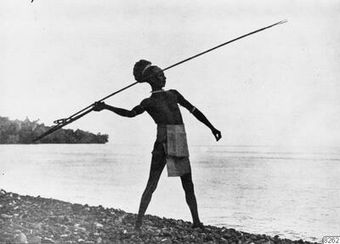Connect with Horniman Museum and Gardens
Contact this content partner to get more information about this item.
spear (weapons: missiles & projectors)
- Description:
- Obsidian-Bladed Spear, Manus Province, Papua New Guinea. The Admiralty Islanders of Manus Province in northern Papua New Guinea traditionally manufactured few weapons, but their throwing spears and daggers of obsidian were produced with great technical skill and artistic refinement, as this fine spear illustrates. This is a composite spear with a reed shaft, a carved wooden foreshaft, and a large flaked obsidian (black volcanic glass) blade. The upper shaft and foreshaft are unified by a covering of putty-nut paste (Parinarium laurinum), which has been overpainted with black, red and white mineral paints in an attractive geometric pattern. Finally, the fibre binding at the top of the shaft has been ornamented with beads of Job’s Tears seeds (Coix lacryma). The people of Manus sourced their obsidian from local deposits on southwestern Manus island and Lou, and this material became an important export commodity for the islanders, who traded it in its raw form with New Guinea mainlanders, and as decorated weapons with Western ships. Such objects became mass produced souvenirs from the early 20th century onwards, but this meant that the artistry deteriorated while the weapons themselves became more gaudy and showy. This example here is a fine late 19th-Century example of the kind of weapons practically used by Admiralty Islanders in battle. Obsidian, wood, bamboo, Parinarium gum, vegetable fibre, seeds, mineral pigments. Late 19th Century. Formerly in the private collection of Mr. W.D. Webster. Composite spear with a reed shaft, wooden foreshaft, and flaked obsidian blade. The upper shaft and foreshaft are covered in Parinarium gum, which has been painted black, red, and white in bands and chequers. The fibre binding at the top of the shaft has been ornamented with seed beads of Coix lacryma.
- Format:
- image
- Collections:
- Horniman Museum and Gardens
- Content partner:
- Horniman Museum and Gardens
- Availability:
- Not specified
-
Copyright status: All rights reservedFind out more about what you are able to do with this itemThis item is all rights reserved, with means you'll have to get permission from Horniman Museum and Gardens before using it. For more information, please see our use and reuse page.More informationHorniman Museum and Gardens has this to say about the rights status of this item:
http://rightsstatements.org/vocab/InC/1.0/
What can I do with this item?Non-infringing useNZ copyright law does not prevent every use of a copyright work, and this item may be hosted by an international institute or organisation. You should consider what you can and cannot do with a copyright work.No sharingYou may not copy and/or share this item with others without further permission. This includes posting it on your blog, using it in a presentation, or any other public use.No modifyingYou are not allowed to adapt or remix this item into any other works.No commercial useYou may not use this item commercially.
Welcome and warm Pasifik greetings
The information on this site has been gathered from our content partners.
The names, terms, and labels that we present on the site may contain images or voices of deceased persons and may also reflect the bias, norms, and perspective of the period of time in which they were created. We accept that these may not be appropriate today.
If you have any concerns or questions about an item, please contact us.

